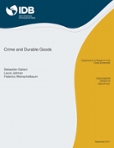Crime and Durable Goods
Date
Sep 2017
Crime and the durability of goods are strongly connected issues. However, surprisingly, they have been studied separately. This paper explores the relationship between the production of durable goods and crime from a theoretical perspective and draws important conclusions for both topics. Crime affects the consumer and producer surplus and thus the behavior of consumers, firms, the market equilibrium, and, in turn, the social optimum. Lower durability of goods reduces the incentive to steal those goods, thus reducing crime. When crime is included in the standard framework of durable goods, the socially optimal durability level is lower. Even without considering the negative non-market externalities of crime, perfect competition does not provide the optimal durability level. When considering different stealing technologies, perfect competition either over-produces durability or produces zero (minimum) durability. The monopolist under-produces durability regardless of the stealing technology considered. If all the crime externalities are taken into account, the socially optimal durability level is reduced further and gets closer to that which prevails under monopoly. The model has a clear policy implication: the durability of goods, and the market structure for those goods, can be an effective instrument to reduce crime. In particular, making the durability of a good contingent upon that good being stolen is likely to increase welfare.




